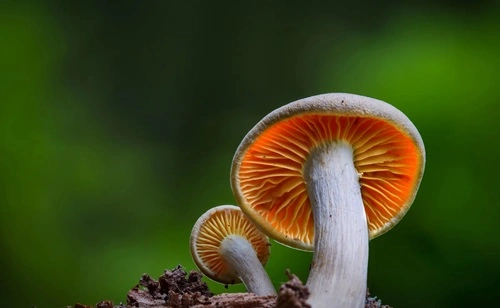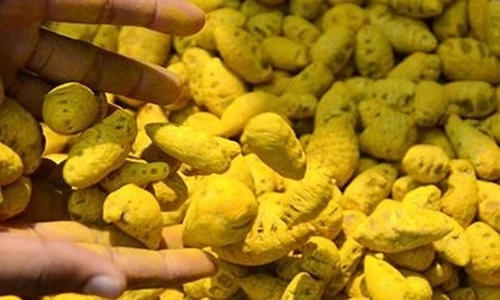Mushroom cultivation, also known as fungiculture, has gained significant importance in Indian agriculture due to its high nutritional value, short cultivation cycle, and economic benefits. Mushrooms are a rich source of protein, vitamins (B and D), minerals (selenium, potassium), antioxidants, and dietary fiber. They are low in calories and fat, making them an excellent dietary choice.
India’s diverse climate enables the cultivation of a wide variety of mushrooms, including edible, medicinal, and gourmet types. Mushroom farming is prevalent in states like Odisha, Haryana, Himachal Pradesh, Punjab, Tamil Nadu, Maharashtra, and Karnataka. Both small-scale farmers and commercial growers are adopting mushroom farming to generate additional income due to its low input requirements and growing demand.
This article provides a detailed list of more than 10 top mushroom varieties cultivated in India, their characteristics, and uses.

1. Button Mushroom (Agaricus bisporus)
Button Mushroom is the most widely cultivated mushroom variety in India and across the world.
- Appearance: Small, white, and round with a short stem.
- Cultivation Temperature: 15°C–20°C
- Regions: Punjab, Haryana, Himachal Pradesh, Uttar Pradesh
- Characteristics:
- Grown in controlled environments on composted substrate.
- Easy to cultivate with high demand in urban markets.
- Nutritional Value: High in protein, vitamin D, and antioxidants.
- Uses: Fresh consumption, soups, pizzas, curries, and processed foods.
2. Oyster Mushroom (Pleurotus spp.)
Oyster mushrooms are the second most cultivated mushrooms in India due to their simple growing process.
- Appearance: Fan-shaped, light grey, white, or pinkish in color.
- Cultivation Temperature: 20°C–30°C
- Regions: Tamil Nadu, Karnataka, Maharashtra, Odisha, West Bengal
- Characteristics:
- Thrives on agricultural waste like paddy straw.
- Grows quickly with high productivity.
- Nutritional Value: Rich in protein, vitamins (B-complex), and fiber.
- Uses: Stir-fries, soups, snacks, and health foods.
3. Shiitake Mushroom (Lentinula edodes)
Shiitake mushrooms are valued for their medicinal properties and gourmet appeal.
- Appearance: Dark brown, umbrella-like caps with light gills underneath.
- Cultivation Temperature: 15°C–20°C
- Regions: Himachal Pradesh, Uttarakhand, Jammu & Kashmir
- Characteristics:
- Requires hardwood logs or sawdust for cultivation.
- Known for its anti-inflammatory and immunity-boosting benefits.
- Nutritional Value: High in antioxidants and vitamins (B and D).
- Uses: Soups, sauces, gourmet dishes, and medicinal extracts.
4. Milky Mushroom (Calocybe indica)
Milky mushrooms are popular in warm and humid climates, making them ideal for tropical regions.
- Appearance: Pure white, large, and thick-stemmed mushrooms.
- Cultivation Temperature: 25°C–35°C
- Regions: Tamil Nadu, Kerala, Andhra Pradesh, Odisha
- Characteristics:
- High yielding with large fruiting bodies.
- Can be cultivated on paddy straw and agricultural byproducts.
- Nutritional Value: Rich in protein, minerals, and essential amino acids.
- Uses: Curries, soups, and fried snacks.
5. Paddy Straw Mushroom (Volvariella volvacea)
Paddy Straw Mushroom is commonly cultivated in tropical climates and rural settings.
- Appearance: Small, umbrella-shaped with a light grey or brown cap.
- Cultivation Temperature: 28°C–35°C
- Regions: Odisha, Tamil Nadu, Andhra Pradesh, West Bengal
- Characteristics:
- Grown on paddy straw under natural conditions.
- Fast-growing with low input requirements.
- Nutritional Value: High in protein and vitamins.
- Uses: Fresh consumption, soups, and stir-fried dishes.
6. Enoki Mushroom (Flammulina velutipes)
Enoki mushrooms are highly prized for their crisp texture and gourmet use.
- Appearance: Long, slender stems with small white caps.
- Cultivation Temperature: 10°C–15°C
- Regions: Controlled environments in urban areas.
- Characteristics:
- Grows well in colder temperatures on sawdust or organic substrates.
- High export demand.
- Nutritional Value: Low calorie, high in fiber and antioxidants.
- Uses: Soups, salads, noodle dishes, and stir-fries.
7. Reishi Mushroom (Ganoderma lucidum)
Reishi mushrooms are primarily grown for their medicinal value in herbal medicine.
- Appearance: Reddish-brown, woody, kidney-shaped cap.
- Cultivation Temperature: 25°C–28°C
- Regions: Himachal Pradesh, Uttarakhand, Kerala
- Characteristics:
- Requires logs or sawdust for growth.
- Known for its adaptogenic and immunity-boosting properties.
- Nutritional Value: Rich in antioxidants and bioactive compounds.
- Uses: Herbal teas, supplements, and extracts.
8. Maitake Mushroom (Grifola frondosa)
Maitake mushrooms are known for their rich flavor and medicinal benefits.
- Appearance: Clustered, feather-like caps in shades of grey and brown.
- Cultivation Temperature: 15°C–20°C
- Regions: Himachal Pradesh, Jammu & Kashmir
- Characteristics:
- Grown on hardwood substrates.
- Contains beta-glucans that support immunity.
- Nutritional Value: High in antioxidants, vitamins, and minerals.
- Uses: Medicinal extracts, gourmet dishes, and stir-fries.
9. Lion’s Mane Mushroom (Hericium erinaceus)
Lion’s Mane is a unique mushroom with cognitive and neurological benefits.
- Appearance: White, shaggy, and resembles a lion’s mane.
- Cultivation Temperature: 18°C–24°C
- Regions: Himachal Pradesh, Uttarakhand
- Characteristics:
- Used for its neuroprotective properties.
- Requires hardwood substrates for cultivation.
- Nutritional Value: Rich in bioactive compounds for brain health.
- Uses: Medicinal supplements, soups, and teas.
10. King Oyster Mushroom (Pleurotus eryngii)
King Oyster Mushrooms are valued for their meaty texture and culinary versatility.
- Appearance: Thick, white stems with small, brown caps.
- Cultivation Temperature: 15°C–20°C
- Regions: Controlled environments in urban areas.
- Characteristics:
- Long shelf life and easy cultivation.
- High demand in gourmet markets.
- Nutritional Value: Protein-rich, low in calories.
- Uses: Grilled, roasted, stir-fried, and gourmet dishes.
FAQs
Q1: Which is the most commonly grown mushroom variety in India?
A: Button Mushroom (Agaricus bisporus) is the most widely grown and consumed variety in India.
Q2: Which mushroom variety is best suited for tropical climates?
A: Paddy Straw Mushroom and Milky Mushroom thrive in warm and humid tropical climates.
Q3: What are the medicinal mushrooms grown in India?
A: Reishi, Shiitake, Lion’s Mane, and Maitake mushrooms are cultivated for their medicinal properties.
Q4: Which mushroom variety is the easiest to grow for beginners?
A: Oyster Mushroom is the easiest variety to cultivate due to its low input requirements.
Q5: What are the nutritional benefits of mushrooms?
A: Mushrooms are rich in protein, vitamins (D and B), minerals, and antioxidants, offering numerous health benefits.
Conclusion
Mushroom cultivation in India is growing rapidly due to its low investment, quick returns, and high demand in domestic and export markets. Varieties like Button Mushroom, Oyster Mushroom, Shiitake, and Milky Mushroom dominate the market, while medicinal mushrooms like Reishi and Lion’s Mane offer additional opportunities. By adopting modern techniques and region-specific varieties, farmers can ensure profitable mushroom farming while contributing to nutritional security.

